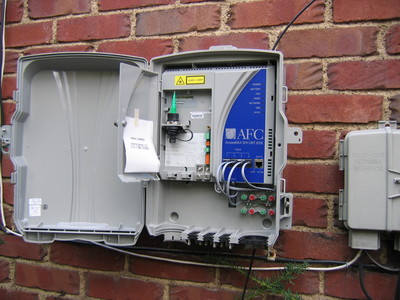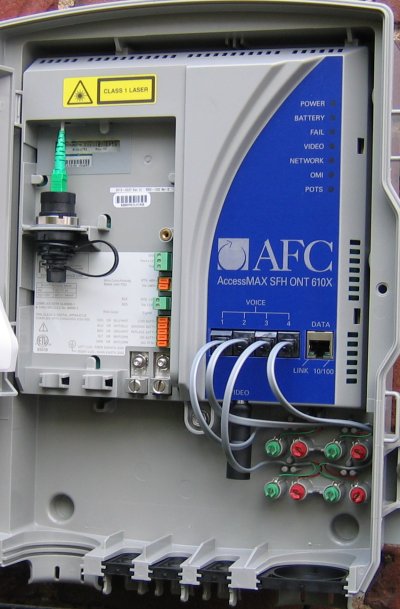Recently I had Verizon’s fiber-optic service “FiOS” installed at my home. The installation process took about a half day and involved placing the following boxes around my house:
- optical network terminal (ONT, installed outside of house)
- battery backup unit (BBU, installed in basement)
- power adapter (plugged into household electrical outlet)
The ONT was installed next to my old POTS junction box:

The ONT acts like a miniature central office. To my house it provides four POTS lines for voice service and one 10/100 Mbps Ethernet port for data service. The ONT accepts a single fiber-optic cable that connects all of these services back to Verizon’s central office.
As part of the installation process, Verizon moved my POTS lines from copper over to the ONT’s POTS interfaces. Verizon wanted to remove my copper-based service altogether, but I forbade them from doing so because I have non-Verizon business lines that I want to keep on copper, which competitive carriers can use to offer me service. (Verizon is not required to share its fiber cables with competitive carriers.)
If you look closely at the ONT, you’ll see that it also is capable of handling video service:

(At present Pennsylvania’s cable-franchise laws prevent Verizon from offering video service, but I’m sure Verizon’s lobbyists are working to change that situation.)
Unlike copper wires, fiber-optic cables do not carry power. The ONT, therefore, must be powered from my home’s electrical service. If the power goes out, the battery backup unit (BBU) will supply power for the ONT’s voice services for about four hours.
VoIP users beware: When the household power fails, the ONT’s data services will be dropped immediately in order to conserve the BBU’s battery. This seems pretty lame to me, but Verizon confirmed this behavior when I called them to ask about it. If you need data service during a power failure, make sure your ONT is powered via a UPS under your control.
To provide data service to my house, the installer ran a CAT-5 cable from the ONT’s 10/100 Ethernet port into my house, where it plugs into a D-Link 4-port “Ethernet Broadband Router,” provided by Verizon for free. Although the provided router has NAT and firewall features, I placed a Linux-based firewall between it and the rest of my home network as an added precaution.
I have been using the service for several days now, and here is my verdict:
It’s just broadband.
Practically speaking, I can’t tell any difference between FiOS and my Adelphia cable-modem service. I ordered 5-Mbps service from both providers, and both services provide about 5 Mbps down, which is faster than fast enough for me. The FiOS service has slightly lower latency – I can ping www.google.com in about 9 ms – and that’s a nice plus.
The big benefit of FiOS is competition: Verizon’s price is about $10/month less than Adelphia’s. When I called Adelphia to cancel my service, their representative attempted to change my mind by offering me a 3-month promotional discount and trying to sell me extra television channels.
I passed.